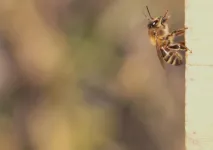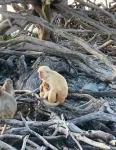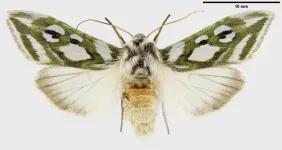(Press-News.org) The goal of Kaare Hartvig Jensen, Associate Professor at DTU Physics, was to reduce the need for harvesting, transporting, and processing crops for the production of biofuels, pharmaceuticals, and other products. The new method of extracting the necessary substances, which are called plant metabolites, also eliminates the need for chemical and mechanical processes.
Plant metabolites consist of a wide range of extremely important chemicals. Many, such as the malaria drug artemisinin, have remarkable therapeutic properties, while others, like natural rubber or biofuel from tree sap, have mechanical properties.
Harvesting cell by cell
Because most plant metabolites are isolated in individual cells, the method of extracting the metabolites is also important, since the procedure affects both product purity and yield.
Usually the extraction involves grinding, centrifugation, and chemical treatment using solvents. This results in considerable pollution, which contributes to the high financial and environmental processing costs.
"All the substances are produced and stored inside individual cells in the plant. That's where you have to go in if you want the pure material. When you harvest the whole plant or separate the fruit from the branches, you also harvest a whole lot of tissue that doesn't contain the substance you're interested in," explains Kaare Hartvig Jensen.
"So there are two perspectives to it. If you want to extract the pure substances, you need to do it cell by cell. And when you can do that, as we've shown, you don't have to harvest the plant. Then you can put the little robot on and it can work without damaging the plant," says Kaare.
The team is currently working with plants and leaves, but in the future this type of harvester may be used on a slightly larger scale.
The hope is that this unique approach can create a new source of biomass and spark research into a new area of sustainable energy production.
One thing the technology might be used for in the future is tapping energy from trees, which contain a lot of biofuel.
"In the forests of northern Canada and Russia, there are spruce forests with around 740 billion trees that are completely untouched. That's about 25% of the total number of trees on the planet. By developing this technology, we can tap trees for sugar and make biofuel without chopping down or damaging the trees," explains Kaare.
Artificial intelligence at a microscopic level
The cells in the fruit and leaves that the harvester looks for are 100 microns in diameter, and the tip of the needle is around 10 microns in diameter. The harvest is therefore happening on the scale of the width of a hair.
Magnus Valdemar Paludan, the PhD student at DTU Physics who created the system of image analysis, image recognition, and robot control, explains.
"It's all done with a microscope camera. To begin with, I manually marked pixels on the microscopy images showing the cells that the robot will harvest. That information can be used to train a computer to find similar cells in new images."
Machine learning and a pre-existing neural network, GoogLeNet, are the building blocks of the technology. The network can already recognize macroscopic structures and can sift through an image and tell you if, for example, there's an elephant or a red pepper hiding in the photo.
"We used a technique called transfer learning, where you use the existing neural network's ability to recognize different objects in an image. By showing the computer a number of new images with the manually marked cells, we succeeded in adjusting the network's parameters so it recognizes the microscopic metabolite-rich cells," says Magnus.
"The harvester can then go in and take a picture of the leaf with the microscope camera, run it through the software, and recognize the cells it needs to harvest. Next, it can extract the chemicals automatically using a microrobot, while the rest of the plant remains undisturbed," explains Magnus.
INFORMATION:
The results stem from Kaare Hartvig Jensen's VILLUM Experiment project, for which he received a grant in 2017. Postdoc Hansol Bae and Jan Knoblauch have also been part of the project.
Facts about VILLUM Experiment
Grants for bold research ideas that are difficult to realize in a classic peer-review funding system.
Awarded for unique research projects that challenge norms and have the potential to fundamentally alter our approach to key questions.
To ensure that researchers have the confidence to submit their most ambitious ideas without being 'disparaged' by the peers who will evaluate their research ideas, the applicants are anonymized. This rule was also introduced to reduce possible bias on the part of the evaluators.
The evaluators are asked to highlight the ideas they see as real innovations. Perhaps only one in 10 projects will turn out to create something unique.
Each expert has the opportunity to assign a 'trump' card to one application. If this happens, it requires powerful arguments for the foundation's board to choose not to support the idea.
The granted awarded is DKK 1-2 million, which must cover a research period of 1-2 years.
The programme is open to all researchers of any nationality, and applications are welcome from active researchers of any age.
When do bees sting and how do they organise their collective defence behaviour against predators? An interdisciplinary team of researchers from the Universities of Constance and Innsbruck has provided new insights into these questions. Their study, published in BMC Biology, combined behavioural experiments with an innovative theoretical modelling approach based on "Projective Simulation". It shows that individual bees decide whether to sting - or not - based on the presence and concentration of an alarm pheromone. The scientists suggest that each bee has a likelihood of stinging that is not constant, but shows at least two internal thresholds for the concentration of the pheromone: one to start stinging and one to stop stinging. The computational modelling also revealed how several environmental ...
A long-standing theory assumes that terrestrial plants could only have developed by entering into a symbiosis with fungi, whereby the two organisms exchange resources in a mutually beneficial way. A new study by an international group of scientists has now confirmed this theory. By studying a liverwort species (a bryophyte related to mosses), the scientists succeeded in demonstrating that a lipid transfer takes place between the plant and the fungus similar to that already known to exist in plants with stems and roots - so called vascular plants. The study was led by French researchers from the Centre national de la recherche scientifique (CNRS) and the Université de Toulouse III - Paul Sabatier, in collaboration with the ...
Researchers at Aalto University in Finland have found strong evidence that warm ice - that is, ice very close in temperature to zero degrees Celsius - may fracture differently than the kinds of ice typically studied in laboratories or nature. A new study published in The Cryosphere takes a closer look at the phenomenon, studied at the world's largest indoor ice tank on Aalto's campus.
Understanding how ice breaks is crucial for ensuring safe harbours and bridges in cool climates, as well as transportation through historically ice-heavy regions. As global warming brings changes to once-predictable seasonal conditions, the rules underpinning infrastructure ...
A paper published in the Journal of Clinical Medicine presents the results from a study which examined the use of an infrared thermal imaging camera as a novel non-invasive point-of-care tool for lymphatic filariasis lower-limb lymphoedema.
Thermal imaging has been used for several decades in a wide range of medical disciplines, but this is the first time it has been used for filariasis or any skin neglected tropical disease (NTD).
LSTM's Dr Louise Kelly-Hope led the research. She said: "Infrared thermal imaging presents an innovative and objective method for quantifying clinical change in filarial lymphoedema status by using naturally emitting infrared radiation to capture skin surface temperatures. This ...
A recent study finds that the vast majority of Black adolescents have experienced racism, that they experience anticipatory stress about experiencing racism again, and that their racial identity can influence that stress in a variety of ways.
"We know that racism is stressful," says Elan Hope, corresponding author of the study and an associate professor of psychology at North Carolina State University. "Part of that stress is anticipatory - waiting for the next racist thing to happen. But not everyone experiences this stress the same way. We wanted to know how racial identity may influence ...
Non-parents expand the range of their facial expressions in caring for infants among primates, a team of anthropologists has found. The study shows the ability, among non-relatives, to both decipher facial expressions and to be attuned to others' emotional states, revealing the evolutionary nature of communication.
The research, which appears in the journal Evolution, focused on the relationship between alloparenting, or infant care by non-parents, and the adoption of detailed facial expressions across more than 30 species of primates.
"Our results confirm previous work indicating ...
FinBIF, which is coordinated and developed by the Finnish Museum of Natural History Luomus of the University of Helsinki:
digitises natural history specimens and produces digital DNA barcodes
collects born-digital observation records of professionals and amateurs alike
integrates data collated from different sources
distributes the data mass as open data
offers data management services, such as platforms for recording and publishing monitoring data and for reporting observations, to researchers, the environmental administration and the public
Typically, different types of species data and the different stages of the data life cycle, that is, digitisation, collection, ...
Whether in desalination, water purification or CO2 separation, membranes play a central role in technology. The Helmholtz-Zentrum Hereon has been working for several years on a new variant: it consists of special polymers that form pores of the same size on the nanometer scale. The materials to be separated, such as certain proteins, can literally slip through these pores. Because these separation layers are very thin and thus very fragile, they are bound to a spongey structure with much coarser pores, providing the structure with the necessary mechanical stability.
"A special aspect is that these structures form in an act of self-organization," says Prof. Volker Abetz, director of the Hereon Institute of Membrane Research and professor of physical chemistry at the University ...
Current wireless networks such as Wi-Fi, LTE-Advanced, etc., work in the lower radio spectrum, below 6 GHz. Experts warn that soon this band will become congested due to mushrooming data traffic. It is calculated that by 2024, 17,722 million devices will be connected.
To meet the growing, ubiquitous demand for wireless broadband connectivity, communication via the terahertz band (THz) (0.1 to 10 THz) is seen as a necessary choice for 6G networks and beyond, due to the large amount of available spectrum in these frequencies.
A study published in the IEEE Journal on Selected Areas in Communications presents a new communication design that ...
Researchers from the Danish psychiatry research-project iPSYCH have contributed to identify 33 new genetic variants which, as it turns out, play a role in bipolar disorder. To achieve this, they have examined DNA profiles from 413,000 people.
A number of scientific working groups are currently attempting to identify the genetic architecture underlying heritable and severe psychiatric disorders such as schizophrenia, depression and bipolar disorder.
One of these working groups is iPSYCH, Denmark's largest research project focusing on psychiatric disorders. Together with international colleagues, they have recently examined the genetic risk factors behind bipolar disorder. The research groups have examined DNA profiles from a total of 413,000 people of European ...





